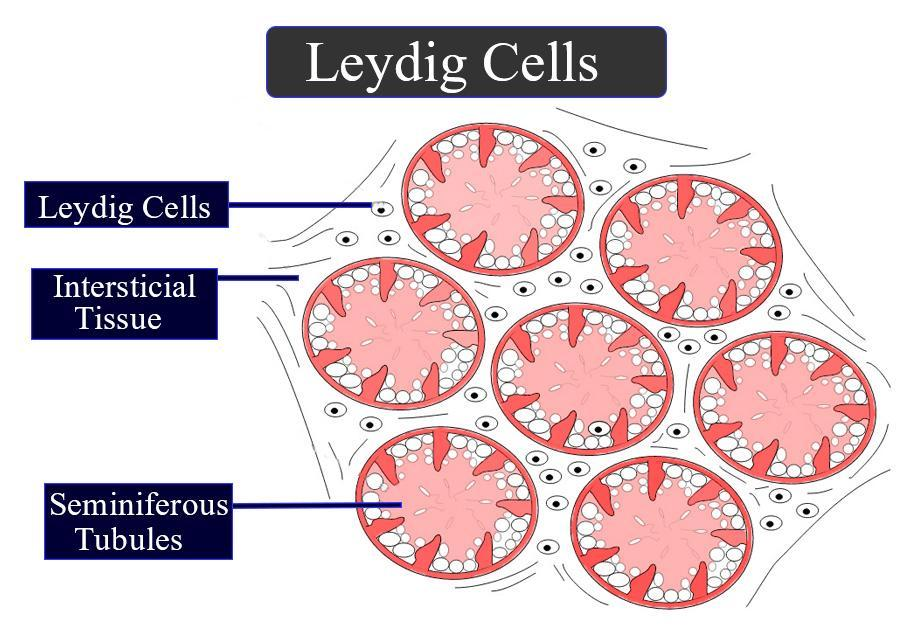
The role of Leydig cells is
(A) Nourishment of sperms
(B) Provide motility to sperms
(C) Bring about the maturation of sperms
(D) Synthesis of testosterone or Androgens
Answer
570.3k+ views
Hint: Leydig cells help in the regulation of the secondary sexual characters which occur during puberty such as facial, chest, and pubic hair growth, change in voice, etc. They are found adjacent to the seminiferous tubule.
Complete answer:
Leydig cells produce testosterone in the presence of a hormone which is known as luteinizing hormone(LH) . They are commonly known as interstitial cells of Leydig. Testosterone comes under androgens which are a group of male sex hormones.

Leydig cells are polyhedral in shape with a single nucleus present in it. Androgens help in managing reproductive functioning in man. Androgens include testosterone, androstenedione, and dehydroepiandrosterone(DHEA) with the help of the LH hormone.
Nourishment of sperm is also necessary for the cell to be healthy and perform it’s functioning effectively. The prostate gland and seminal vesicles provide fluids which help in providing nourishment to the sperm cells and also provide fluid that lubricates the duct system.
Even in some cases like Polycystic ovary syndrome (PCOS) causes androgen production in females. This has many side effects seen in females like the growth of facial hair, acne, irregular menstrual cycles. Even a very high level of androgen can cause infertility in females. If the testosterone level is low in males, it can be maintained at a normal level by Hormone Replacement Therapy.
So, the correct answer is ‘Synthesis of testosterone or Androgens’.
Note: Testosterone is a very important hormone. It helps in normal sperm development and sperm count. It activates the genes which are present in Sertoli cells, which further promote differentiation of spermatogonia.
Complete answer:
Leydig cells produce testosterone in the presence of a hormone which is known as luteinizing hormone(LH) . They are commonly known as interstitial cells of Leydig. Testosterone comes under androgens which are a group of male sex hormones.

Leydig cells are polyhedral in shape with a single nucleus present in it. Androgens help in managing reproductive functioning in man. Androgens include testosterone, androstenedione, and dehydroepiandrosterone(DHEA) with the help of the LH hormone.
Nourishment of sperm is also necessary for the cell to be healthy and perform it’s functioning effectively. The prostate gland and seminal vesicles provide fluids which help in providing nourishment to the sperm cells and also provide fluid that lubricates the duct system.
Even in some cases like Polycystic ovary syndrome (PCOS) causes androgen production in females. This has many side effects seen in females like the growth of facial hair, acne, irregular menstrual cycles. Even a very high level of androgen can cause infertility in females. If the testosterone level is low in males, it can be maintained at a normal level by Hormone Replacement Therapy.
So, the correct answer is ‘Synthesis of testosterone or Androgens’.
Note: Testosterone is a very important hormone. It helps in normal sperm development and sperm count. It activates the genes which are present in Sertoli cells, which further promote differentiation of spermatogonia.
Recently Updated Pages
Master Class 12 Business Studies: Engaging Questions & Answers for Success

Master Class 12 Economics: Engaging Questions & Answers for Success

Master Class 12 English: Engaging Questions & Answers for Success

Master Class 12 Maths: Engaging Questions & Answers for Success

Master Class 12 Social Science: Engaging Questions & Answers for Success

Master Class 12 Chemistry: Engaging Questions & Answers for Success

Trending doubts
What is meant by exothermic and endothermic reactions class 11 chemistry CBSE

Which animal has three hearts class 11 biology CBSE

10 examples of friction in our daily life

One Metric ton is equal to kg A 10000 B 1000 C 100 class 11 physics CBSE

1 Quintal is equal to a 110 kg b 10 kg c 100kg d 1000 class 11 physics CBSE

Difference Between Prokaryotic Cells and Eukaryotic Cells




